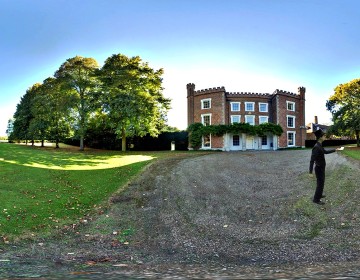You have a body. You have Facebook profile. Both are real, but we tend to divide the digital from the “real.” We use terms like “augmented” and “virtual” implying that such things are not, in themselves, real. We hold online conversations below those that occur face:to:face. We draw a line between the life of our bodies and the life of our Facebook profiles.
If this line ever existed, it is increasingly blurred. Wearable technologies like Google Glass and Oculus Virtual Reality (VR/AR) narrow the perceived space between the physical and the digital, what we currently identify as “virtual” versus “real.” The last decade has found us comfortable with falling in love, finding material for sexual release and going to college in the digital realm. All of these experiences, while digitally accessed, are still real, often even embodied. What other digital experiences might we someday consider real? The artist has always dwelled in controversial definitions of reality. Consider, especially, The Surrealists. It is for this reason we chose art as a way to explore current limits on the definition of reality.
The vivid and immersive nature of VR/AR grant the possibility of real pain and joy, experienced in what we currently consider “non” real. It is not difficult to imagine VR/AR experiences that modify the way we live and respond in the physical. Whether you consider Samantha in the movie “Her” to be real, it is hard to argue that Theodore Twombly’s pain was “virtual”. We need to grant digital the seriousness of “real.” This concept is called Digital Monism, the belief that our human world is inseparably digital and non-digital, online and offline. In a digital monist view, you cannot remove the online side of your relationships or self from the offline side of it.

You have a body and I have a painting. This painting is in a large studio in East London. The canvas is heavy, at times inconveniently large. If I paint too long my hand will cramp. This painting is also digital on Instagram, YouTube, and in Digital De Re Gallery, a fully immersive VR/AR gallery. When you see my painting in VR/AR you are still seeing my painting, but it isn’t exactly the same.
When you put on a VR/AR device and enter Digital De Re Gallery the paintings animate, change in size, transform into different versions, transport you to new places in space and time. The paintings become an interface, acting as a shared boundary between the viewer and the additional offerings of the paintings.
The physical De Re Gallery is located in West Hollywood’s Design District. It is full of light, vision, and personality. When designing a VR/AR home, which we created with the London developers Amplified Robot, we chose to mirror De Re Gallery’s design to emphasise the connection to the West Hollywood location. After putting on Oculus Rift you are taken to a 360-degree immersive gallery. There are windows on to Melrose Ave, lighting figures giving light and ambient sound. You can move through the space, viewing each painting and it’s related animation.
Digital De Re Gallery is reality unlimited by the normal constraints of both the physical and the digital. The paintings move seamlessly between physical and digital, further blurring the line between the two. I make large oil paintings. It’s expensive, toxic and inconvenient but also important to me. My decision of when to be physical and when to be digital is endowed with meaning, purpose, historical reference, and is highly personal.
When should we be digital and when should we be physical? This is the choice of the artist, but it is also yours. For the author Michael Pollan, “Apart from eating, gardening, short-haul driving, and sex, I generally prefer to delegate my commerce with the physical world.” To consider this list for yourself is to admit that our bodies are only part of ourselves. We can see the choices of the artist as a framework to consider our own decisions about what we keep physical and what we make digital, holding both to be real.
Should love letters be written but meetings notes emailed? Maybe you like to cook. Chop up onions, whatever. You may want to use your own body for kissing but your digital self for attending early morning conference calls. The physical is thus an expanded medium of meaning, especially when you choose to use your body when you no longer need to. Expanded digital options for work and interaction transform our bodies into increasingly specialized hardware, repurposed for the physical tasks that actually matter to us.
Whatever our engagement with the digital, the body still remains the mode of experience. A virtual roller coaster can still make your heart race. The physical body is still the temple from which our ideas and interpretation occur. If we think of reality this way, inseparably digital and physical and governed by personal choices we exist as more integrated people, self aware to the way the world is changing.
You put on Oculus and find yourself in a beautifully designed gallery in West Hollywood. How does it feel to move and experience in digital space? Interact with the paintings. Watch them reveal initial drawings, show their own making and transform in ways only possible in the digital. This is De Re Gallery. This is my painting. This is my body, no longer broken into real and digital. Whether you visit in West Hollywood or VR/AR is entirely up to you.
You can download Digital De Re Gallery in the App Store.

test
etst